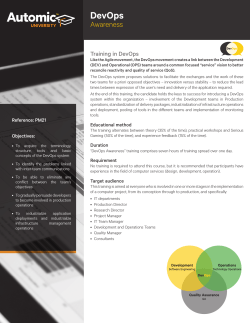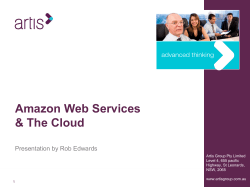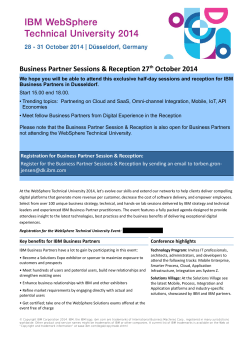
Implementing End-to-End Integrated DevOps in a Fortune 100
Implementing End-to-End Integrated DevOps in a Fortune 100 Hybrid Cloud Environment DTS-3097, Sunil Joshi © 2014 IBM Corporation Please note IBM’s statements regarding its plans, directions, and intent are subject to change or withdrawal without notice at IBM’s sole discretion. Information regarding potential future products is intended to outline our general product direction and it should not be relied on in making a purchasing decision. The information mentioned regarding potential future products is not a commitment, promise, or legal obligation to deliver any material, code or functionality. Information about potential future products may not be incorporated into any contract. The development, release, and timing of any future features or functionality described for our products remains at our sole discretion. Performance is based on measurements and projections using standard IBM benchmarks in a controlled environment. The actual throughput or performance that any user will experience will vary depending upon many factors, including considerations such as the amount of multiprogramming in the user’s job stream, the I/O configuration, the storage configuration, and the workload processed. Therefore, no assurance can be given that an individual user will achieve results similar to those stated here. © 2014 IBM Corporation Contents • • • • • • • • DevOps and Hybrid Cloud Hybrid DevOps Use Cases Company A - DevOps Case Study Company A – DevOps Application Delivery Pipeline Hybrid DevOps Architecture Pathway to Hybrid DevOps Adoption Hybrid DevOps Cloud Governance Lessons Learned and Best Practices 2 DevOps and Hybrid Cloud Hybrid model of delivery for Cloud and DevOps solutions is inevitable !!! It’s not a choice. • Enterprises have built-in IT capabilities • Security Models • Governance and Support models • Best of breed SaaS & PaaS capabilities • Move towards Managed Service offerings • Focus on core business 3 Hybrid DevOps Use Cases 1. Development and Test on public cloud with production on private cloud or physical infrastructure in On-premise datacenters. 2. 'Cloud Bursting' from private to public cloud for temporary capacity needs. 4 Hybrid DevOps Use Cases 3. Organizations delivering System of 4. Organizations need application Engagement applications need to workloads that are portable across connect to System of Record applications private and public clouds. on mainframes and distributed physical infrastructure. 5 Hybrid DevOps Use Cases 5. Experimentation of innovative applications on public cloud or PaaS platforms will need to be brought inhouse if successful. 6. Organizations looking to outsource Test environment management. 6 Hybrid DevOps Use Cases 7. Organizations transitioning to cloud will have applications on both legacy systems on physical infrastructure and cloud during transition periods. 8. Organizations wanting to avoid 'vendor lock-in' with single cloud platform for the enterprise. 7 Hybrid DevOps Use Cases 9. DevOps platform across multiple infrastructure and/or service providers 8 Company A - DevOps Case Study Objectives • Each tower within company A operate Application Lifecycle Management (ALM) process in silos and disconnected manner • No enterprise level standardized ALM process, methods or tools • Limited or no build, deploy, test automation • Longer release cycles, unnecessary delays, and wasted resources Problem Statements • Accelerate software delivery • Balance speed, cost, quality and risks • Improve client experience • Standardization of technology stack • “Patterns” based provisioning • Standardization of development methods and tools • Automation of build, release and deployment processes • Embracing a hybrid model to maximize Cloud and DevOps value • Select the right client leader Solution 9 Company A - DevOps Application Delivery Pipeline 10 Hybrid DevOps Architecture 11 Path to Hybrid DevOps Adoption • Standardization of technology stack • “Patterns” based provisioning • Standardization of development methods and tools • Automation of build, release and deployment processes • Embracing a hybrid model to maximize Cloud/DevOps value DevOps Reference Architecture 12 Hybrid Cloud Governance Extension of traditional Information Technology Infrastructure Library (ITIL) processes DevOps takes the ITIL processes and applies Agile and Lean methodologies DevOps is the process integration between the areas of configuration, change, and release management and deployment through workflow automation Ability to consistently manage release and deployment dependencies between different types of enterprise workloads (such as mobile, analytics, web applications etc) Cloud Governance Framework 13 Lessons Learned and Best Practices Lessons Learned: • • • Managing multiple support models based on existing agreements • SLA complications Balance between Managed DevOps vs. Developer empowerment Security Integration with existing model • User and License management Best Practices: Standardize and consolidate development tools Conduct deep-dive workshops for several business units, not just at enterprise level (Bottoms up vs. Top down) 14 Thank You Your Feedback is Important! Access the InterConnect 2015 Conference CONNECT Attendee Portal to complete your session surveys from your smartphone, laptop or conference kiosk. Backup Charts 16 Acknowledgements and Disclaimers Availability. References in this presentation to IBM products, programs, or services do not imply that they will be available in all countries in which IBM operates. The workshops, sessions and materials have been prepared by IBM or the session speakers and reflect their own views. They are provided for informational purposes only, and are neither intended to, nor shall have the effect of being, legal or other guidance or advice to any participant. While efforts were made to verify the completeness and accuracy of the information contained in this presentation, it is provided AS-IS without warranty of any kind, express or implied. IBM shall not be responsible for any damages arising out of the use of, or otherwise related to, this presentation or any other materials. Nothing contained in this presentation is intended to, nor shall have the effect of, creating any warranties or representations from IBM or its suppliers or licensors, or altering the terms and conditions of the applicable license agreement governing the use of IBM software. All customer examples described are presented as illustrations of how those customers have used IBM products and the results they may have achieved. Actual environmental costs and performance characteristics may vary by customer. Nothing contained in these materials is intended to, nor shall have the effect of, stating or implying that any activities undertaken by you will result in any specific sales, revenue growth or other results. © Copyright IBM Corporation 2015. All rights reserved. – U.S. Government Users Restricted Rights - Use, duplication or disclosure restricted by GSA ADP Schedule Contract with IBM Corp. IBM, the IBM logo, ibm.com, Interconnect, [IBM Brand, if trademarked], and UrbanCode are trademarks or registered trademarks of International Business Machines Corporation in the United States, other countries, or both. If these and other IBM trademarked terms are marked on their first occurrence in this information with a trademark symbol (® or ™), these symbols indicate U.S. registered or common law trademarks owned by IBM at the time this information was published. Such trademarks may also be registered or common law trademarks in other countries. A current list of IBM trademarks is available on the Web at “Copyright and trademark information” at www.ibm.com/legal/copytrade.shtml Other company, product, or service names may be trademarks or service marks of others. • REMINDER: Please follow the guidelines for copying third party materials. Third party screen shots, logos, presentations and website content are copyrighted materials owned by the third party, and as such we need permission from the third party to use them. Also, be sure the information you put on a chart is verifiable. Be sure to cite the source on your deck when using words, ideas, facts, photos, news clips or other expression that did not originate from yourself. This applies even if the content is publicly available and not confidential. If you have any questions, please contact your IP Attorney. Resources DevOps for Dummies Challenges of Hybrid Cloud on DevOps Adoption Contact sunjoshi@us.ibm.com Linkedin Twitter 18
© Copyright 2025















